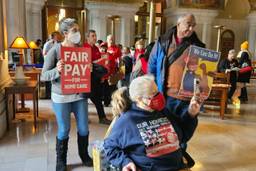How Kathy Hochul Abandoned Home Care Workers
Hochul broke her promise, but home care advocates are still fighting to make sure New York “takes care of the people who take care of people.”
Lily Meyersohn
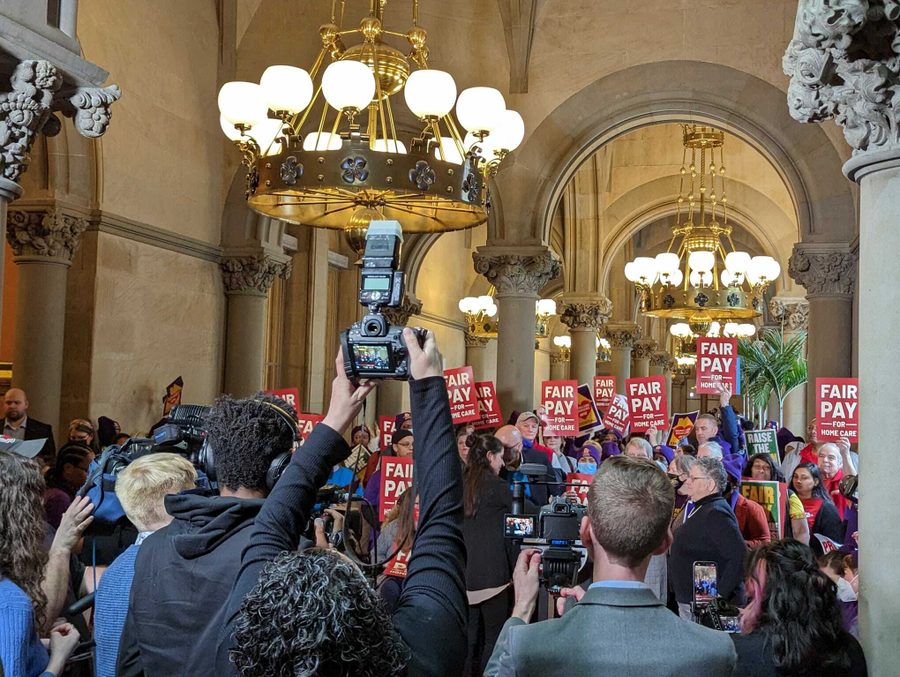
In a bright fourth floor alcove in Albany’s Capitol building, a crowd of home care workers and their allies had gathered. Among them was Renee Christian, a 34-year-old Buffalo-based single mother, health and wellness coach and home care user. Christian held up a sign that read, “Because of home care, I can go to the bathroom.” Addressing workers at the February 6 rally, she said, “I wouldn’t be able to live like I live without you guys.”
But every week, Christian — who takes part in the state’s consumer-directed home care program — has to worry about securing full coverage. Right now, she has staff who come to her home from 9 a.m. to 2 p.m. and from 10 p.m. to 8 a.m., but not on Friday, Saturday or Sunday. “I love my [care] workers,” she tells In These Times. “They’re like family to me.” But it’s hard to find full coverage, “especially for $15.20 an hour,” which is the minimum wage for upstate home care workers. Christian has considered supplementing aides’ wages with her own resources — in 2021, friends even started a GoFundMe to help her with that goal.
She is by no means alone. A 2019 survey by the Home Care Association of New York State found that roughly a quarter of patients were unable to find home care workers. The state’s care shortage is considered the most severe in the country.
Christian says low wages have already pushed one of her regular aides, Denise White, to consider leaving the sector because White “can make more money somewhere else.” Research confirms that the state’s care shortage is primarily driven by the sector’s low wages. According to one study, seven out of 10 home care users in upstate New York said that their aides quit due to low wages. And the problem is set to get worse, with a recent report finding that more than 4.6 million New Yorkers will be over age 65 by 2035 — an increase of 29% in the next decade.
Broken promises
When she was first running for governor of New York, Kathy Hochul promised to do something about the ongoing crisis by increasing the home care minimum wage. And once she came into office, she acted on the promise, raising the wage from $13 to $16 upstate, and from $15 to $18 downstate. (Those wage increases are in the middle of being implemented.) The raises were part of Hochul’s 2023 executive budget, which made a landmark $7.7 billion investment in the industry. The budget also stipulated that in subsequent years, the home care wage would always remain $3 above the statewide minimum wage.
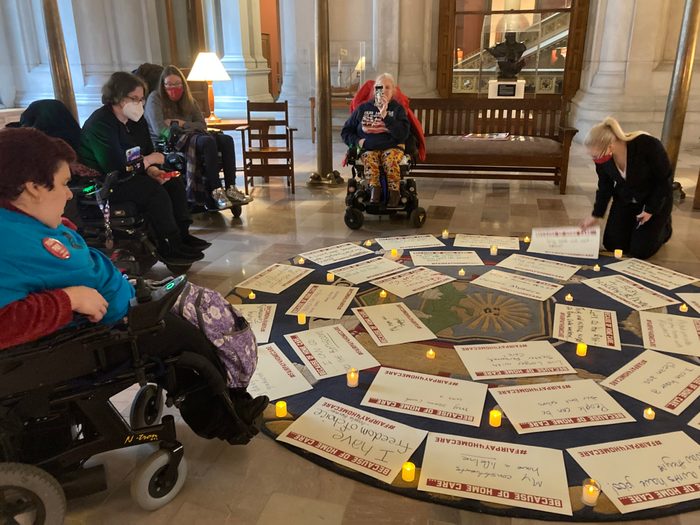
But over time, advocates say Hochul’s commitment to home care seems to have waned. On February 1, she proposed a 2024 budget that would overturn the stipulation that the home care minimum wage remain $3 above the state minimum wage. Instead of at-home care, the governor’s budget invests in nursing homes, increasing their Medicaid reimbursement rate by 5%.
Ilana Berger — director of Hand in Hand, a national network of employers of nannies, house cleaners and home attendants working for better working conditions — says “budgets are a reflection of the state’s priorities,” and Hochul’s budget represents a “prioritization of institutional care over home and community-based care.” She adds that “the state’s decision to deepen investments in nursing homes is in direct conflict with the preferences of most New Yorkers: the vast majority of residents would prefer to live and age in their home.”
Christian is outraged at Hochul’s decision to invest in nursing and group homes rather than home care for New York’s vulnerable. After being placed in such institutions at age 11, Christian fought for years to get out. A home care user for almost 15 years now, Christian has a ten-year old daughter, a coaching business and a community where she wants to stay. A nursing home, she feels, “would take away who I am.”
Without staff at home on a recent Friday, Christian had to wait eight hours to get changed after having an accident. “It’s dehumanizing,” she says. It might be more convenient for the state if she simply went into a nursing home “because then someone would be there to change me,” she says. “But what quality of life would that give me?”
Back to minimum wage
Under Hochul’s new budget, home care workers’ wages would freeze at $18 an hour for several years to come. Advocates feel that home care workers deserve more. They do “life-saving work,” says Berger. “They should not be paid the minimum wage.” But on February 28, during the Joint Legislative Public Hearing on Health and Medicaid, Acting Health Commissioner James McDonald and Medicaid Director Amir Bassiri both admitted that with the home care wage frozen at $18, home care will soon return to a minimum wage job once the minimum wage rises to $18 in 2029 or 2030.
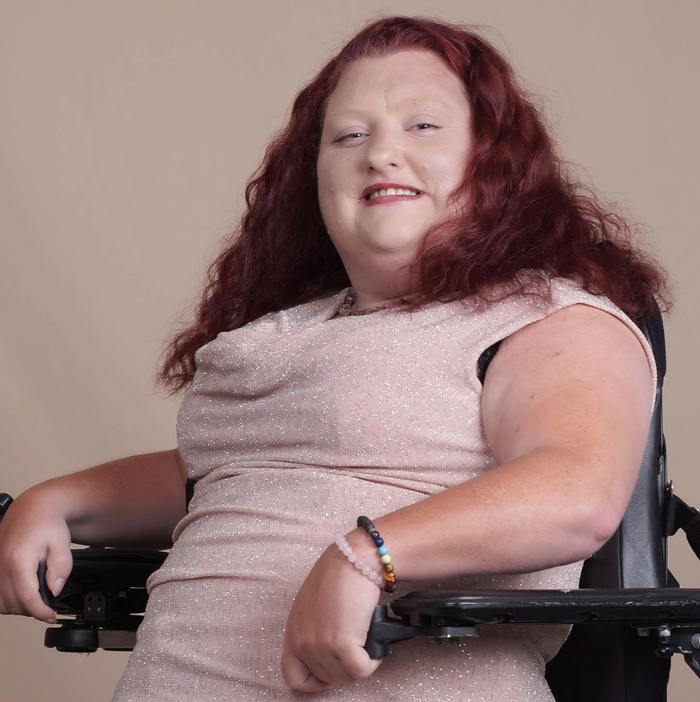
Home care advocates believe that returning home care to a minimum wage job is particularly concerning given that under Hochul’s budget, the state minimum wage is not a living wage. Department of Health (DoH) spokesperson Jeffrey Hammond wrote in an email to In These Times that the budget indexes the state’s minimum wage to inflation, but advocates say the proposal is not truly indexed to inflation because it caps wage increases at 3%. That would mean that workers wouldn’t get a raise in the years they most need it; their wages would fall behind in years like this one, where inflation is over 6%.
For its part, the Governor’s office denies that the budget will further weaken the home care sector. Hammond tells In These Times that “there is nothing in the budget that would reduce wages for home health care workers.” He adds that the $7.7 billion dedicated to the sector last year will not be impacted whatsoever by the governor’s new minimum wage proposal. But in a press release from the New York Caring Majority — a coalition of several organizations that advocate for seniors, people with disabilities, family caregivers and home care workers — Berger argues that this budget ensures that the home care shortage will grow in coming years.
Eroding patients’ autonomy
Some workers, including Christian’s aides, will also be excluded from wage gains under the new plan. Rather than letting a traditional home care agency assign her an aide, Christian hires her aides through the Consumer Directed Personal Assistance Program (CDPAP), a Medicaid program that allows long-term home care users to recruit, hire and direct their own care. CDPAP gives home care users more control over their own care decisions. Though Christian hires aides from within the community, the program also allows home care users to hire some family members as caretakers.
In Buffalo, Reverend Denise Walden-Glenn’s family has benefited from the program since 2008. She brought home her youngest son from the hospital that year; he was born a micro-preemie (a term used to refer to babies born before the 26th week of pregnancy or weighing under 28 ounces) and has required significant care at home since, including a heart monitor and portable oxygen. CDPAP allowed her oldest son to become her youngest’s caretaker and earn an income that way, while Walden-Glenn went back to work to support the family. These days, her youngest is “thriving.” Walden-Glenn largely attributes his well-being to the fact that his brother, who knows the ins and outs of his needs, has been able to care for him.
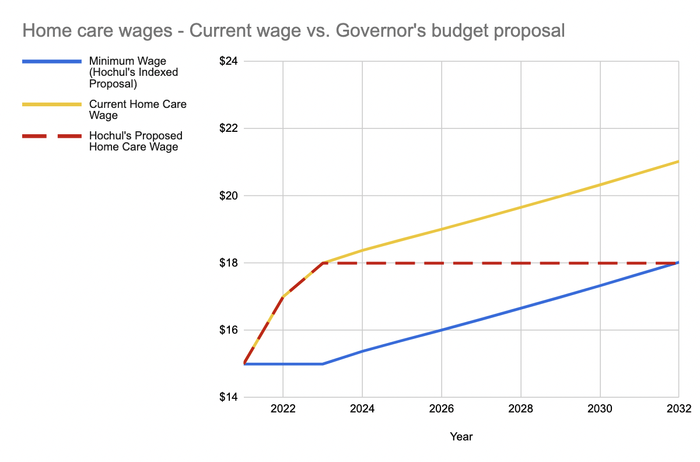
To support a truly community-based type of care, advocates
say these workers need to be included in any wage gains. But Hochul’s
wage proposal excludes CDPA workers. Rather than increasing their wages,
the budget increases their health insurance subsidies.
Helen Schaub, vice president of 1199 SEIU United Healthcare Workers
East, says that this move could result in wage and benefit cuts of $4.09 per hour
for more than 100,000 downstate CDPAP workers, undermining the victory
by the movement last year. In his testimony for the joint legislative
budget hearing, Bryan O’Malley, the executive director of Consumer
Directed Action of New York, an organization that advocates for and
supports CDPA providers and recipients across the state, said Hochul’s
plan would make CDPA aides “second-class home care workers.”
Hochul’s executive budget makes both Christian and Walden-Glenn nervous. Walden-Glenn says that her family has benefited from getting to decide “who comes into our house to provide care.” That autonomy, she says, is eroded by the current budget proposal.
A home care movement
Facing an April 1 budget deadline, state lawmakers have just a few days left to alter these conditions. As that deadline approaches, the state’s home care activists are descending on Albany to make their voices heard.
The coalition fighting for fair pay for home care workers includes organizations like the AARP (a group representing Americans of retirement age), government agencies focused on aging, and the home care advocacy groups involved with New York Caring Majority. This is “a set of organizations that have maybe never come together in this way,” Berger says.
Together, the groups successfully advocated for the initial wage increase in 2022. At the February 6 press conference, state senator Rachel May told the crowd: “We did an amazing thing together. We inspired everyone in this building.” By the time the budget passed, the coalition had also garnered bipartisan support for their signature legislation — S3189. Otherwise known as the Fair Pay for Home Care Act, the law would permanently index the home care minimum wage to 150% of statewide minimum wage. But despite widespread support for the bill in Albany, Hochul has still not included the bill’s full text into the executive budget.
If passed and implemented, S3189 is projected to end the worker shortage in just five years. In ten, it promises to create over a quarter of a million new jobs for women, including 181,000 new jobs for women of color. Currently, 91% of the home care workforce in the state is female and 77% is people of color. The legislation would also lift these workers—58% of whom currently receive public assistance and 47% of whom lack access to affordable housing — out of poverty wages. By moving home care workers off of social assistance and creating new jobs in the sector, it is estimated that New York would see increased revenues of $5.4 billion.
Two months ago, when Christian gathered at the Capitol alongside other home care allies, they were there to reintroduce that bill, which they first introduced in 2021 and helped to popularize in the intervening years. The action was the first of several events held in both New York City and the state capital in protest of what stakeholders see as the failings of the executive budget. After their early February protest, home care advocates gathered again in Albany on March 8. Under the I Heart NY sign next to the Capitol, they built a sculpture of some of the items that home care workers carry to and from work each day: disposable gloves, bandages, catheters, water bottles, car keys, compression garments, pill bottles, shoes, bath benches. The altar was meant to honor home care workers’ labor and to bring visibility to the coalition’s struggle.
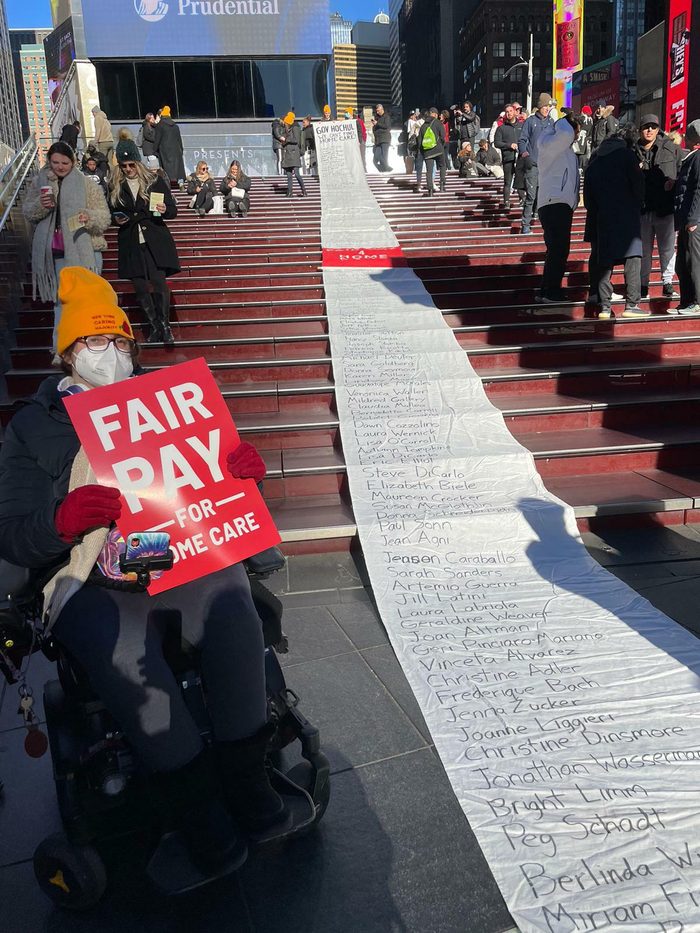
On March 20, the coalition handed over 8,000 letters from older adults to the governor demanding fair pay for home care. And during the last week of March, they have maintained a daily presence at the state Capitol and organized a series of actions. One group dressed up as Governor Hochul and insurance company CEOs to put on a small theater production; another, made up of octogenarians from the Chinese-American Planning Council, performed a dance for home care; and a third gathered to deliver the governor a 100-foot scroll with the names of hundreds of New Yorkers who are currently waiting for home care.
The pressure from the movement is beginning to have effects. In March, both the State Senate and the Assembly proposed significant amendments to the executive budget around issues of home care. While the Assembly One-House restores indexing the current home care wage to $3 over the minimum wage, the Senate One-House recommendation goes further, restoring the index and also adding $2 in increases — $1 per year in 2024 and 2025. That would mean home care workers would be paid $5 above minimum wage. The one-house budgets are recommendations, so it’s in Governor Hochul’s power to amend her executive budget so that it reflects the legislature’s intentions.
Any one of these changes would be an improvement on the current budget, but ultimately, activists are fighting for more. “If we want to be a state that prioritizes care,” Christian says, then the executive budget “needs to include the full language of the Fair Pay for Home Care Act.” For many, this is a fight to ensure the home care sector’s longevity. It is also a fight to ensure that, in Denise Walden-Glenn’s words, New York can “take care of the people who take care of people.”
Lily Meyersohn is a researcher for the Institute for Public Accuracy and a freelance health and politics reporter. She can be reached at @LMeyersohn.
